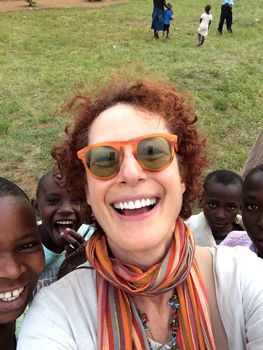An Artist's Perspective

Rwanda is Mille Colines, The Land of a Thousand Hills; it is gorgeous, lush, and green. Local folklore says that God wanders the world during the day and comes home to Rwanda to sleep at night.
Yet I study photos of bodies piled up at roadblocks on Kigali streets taken during the 1994 genocide. Just 20 years ago one million Tutsi were murdered in Rwanda, often by their own neighbors or friends. Hutu who did not comply were targeted and murdered, as well. Driving through downtown, we pass a large brick church, Saint Famille—so clean, so modern—where thousands of people, believing they had found sanctuary, were betrayed. Driving out of town, we cross the bridge over Nyabarongo River which was, 20 years ago, clotted with corpses; the water ran red with blood.
I am a theater artist. I am here in Rwanda, at the moment of the 20th commemoration, confronting the genocide, as a witness and translator of what I see, hear, and feel.
In their daily lives it’s difficult for most people to engage with narrative related to catastrophe or mass atrocity. The experiences survivors describe are complex, deeply disturbing, on so many levels. Artists, however, by virtue of what they are trained to do, stand in witness with the intention of bringing forth expression with which a broad audience can engage. This is useful: Engagement is the first step toward prevention.
Loss is something that most of us, on some level, have experienced. Loss is the obvious entry point here. Yet the hundreds of memorial sites where people perished during the genocide in Rwanda represent loss beyond our comprehension; at a single site, tens of thousands may have lost their lives. Some of the victims are buried in coffins, as one would expect, but in some cases the remains of 50 or more share a single box. Many of the dead have never been buried; skulls intact, sliced open by machete, smashed by club, riddled by bullets, are arranged on shelves, row after tidy row of skulls. I study them; take in the elegance of the human head, so many, so beautiful. Most of the remains are anonymous, but some of the skulls are known, and despite the universal imperative for “burial with dignity,” there are families that choose not to bury their dead. They prefer to have them above-ground as evidence and a silent form of testimony. Survivors want visitors to be confronted by the proof that genocide happened here in this place, and it happened to them. The unburied are all strangers to me. In their presence, I am touched by the intimacy of my connection with them, naked as they are.
In everyday life, Rwandan traditions surrounding death and loss have a grace and fluidity, much like the Jewish tradition in which I was raised. Like shiva, in which the community gathers around a family in the immediate days after a death, so neighbors and friends here will sit around a bonfire at the back of the deceased’s family home and remember good times. They sing songs, tell stories and jokes, and present poems in honor of the person who has died. If it’s the head of family who has gone, there is a ceremony whereby the mantle of responsibility is passed on to their heir.
Genocide smashes through the native intelligence that lived in this culture with regard to mourning—moving from life to death to life—just as the Holocaust smashed through all the dignified traditions of the Jewish community. Everything Rwandans knew about negotiating their way through the inevitability of loss, folding in grief, doesn’t serve survivors here. What happened is too awful; it’s inhuman, unbearable. We cannot breathe, and therefore we cannot move beyond that never-ending moment of trauma.
That is why testimony is so essential: It allows survivors to breathe, to give voice to what happened. Bones may be eloquent, but they are silent; testimony allows an individual the opportunity to say out loud, “This really happened; it happened here; it happened to us.”
For Rwanda, 20 years after the genocide, “This really happened” remains a vital story to tell. There are those who deny there was a genocide. There are perpetrators who live abroad with impunity, some are quiet, some not so quiet. Some are armed.
I am a visitor; I have come here to look, listen and learn. I observe—alongside the profound imperative for remembrance, testimony and dialogue about the genocide—there is an intentional reach to identify with Rwandan culture and traditions. I am moved by this reach to the spirit of dignity (agaciro) that has always been, as a reach for the strength to be humane in a landscape that was not so long ago bereft of all humanity, and to move forward as a unified people.
With the genocide, Rwanda is changed forever, and when we engage with the history of Rwanda and the Rwandan people, we too are changed. I am in awe of the courage I see here, the courage to love with all one’s heart what has been so brutally lost; to float on a stream of unspeakable grief, to ride it, breathe into it, speak it, find safety in one another, and weave that grief into the fabric of a new, changed life.
None of this is easy, of course: there is no strength without obstacle, no courage without fear. Rwandans are the last to presume to be role models, yet, as they move into the future, there is so much to be learned.
Kwibuka means ‘remember’ in Kinyarwanda, Rwanda’s language. It is used to describe the annual commemoration of the 1994 Genocide against the Tutsi. To learn more about Kwibuka20, the 20th anniversary commemoration, visit: http://www.kwibuka.rw/